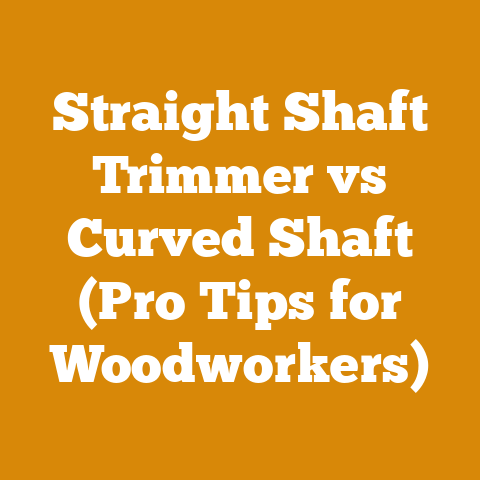Chain for Chainsaw Oregon: Guide to Types & Sizes (7 Key Specs)
Let’s debunk a myth right off the bat: chainsaw chains aren’t indestructible. I’ve seen too many folks treat them like they are, only to end up with a dull, dangerous, or even broken chain. Choosing the right chain for your chainsaw is as crucial as selecting the right saw itself. Whether you’re felling trees, bucking logs for firewood, or doing some intricate carving, the chain you use makes all the difference in efficiency, safety, and the longevity of your equipment.
This guide will delve into the seven key specifications you need to understand when selecting an Oregon chainsaw chain. I’ll break down each element in detail, drawing on my experience in logging, firewood preparation, and general wood processing to provide practical insights and advice.
Why Chain Selection Matters
I’ve spent years in the woods, and I can tell you firsthand that the right chainsaw chain can transform a frustrating, time-consuming task into a smooth, efficient operation. Conversely, using the wrong chain can lead to:
- Reduced Cutting Efficiency: A dull or incorrect chain will require more effort and time to cut through wood.
- Increased Wear and Tear on Your Chainsaw: A mismatched chain puts extra stress on the saw’s motor and bar, leading to premature failure.
- Safety Hazards: A poorly fitted or improperly sharpened chain can kick back, increasing the risk of injury.
- Poor Cut Quality: An incorrect chain can result in rough, uneven cuts, which is especially problematic for woodworking or milling.
Oregon Chainsaw Chains: A Brief Overview
Oregon is a well-respected name in the chainsaw chain industry. They offer a wide range of chains designed for various applications, from light-duty homeowner use to heavy-duty professional logging. Their chains are known for their durability, performance, and innovative features. Throughout this guide, I’ll be referencing specific Oregon chain models to illustrate key concepts.
Key Terms and Concepts
Before diving into the seven key specifications, let’s define some essential terms:
- Drive Links: These are the small metal pieces that fit into the groove of the chainsaw bar and are driven by the sprocket.
- Cutters: These are the sharp teeth that do the actual cutting. They come in various shapes and sizes, each designed for specific cutting tasks.
- Tie Straps: These connect the drive links and cutters, holding the chain together.
- Gauge: The thickness of the drive links, which must match the groove width of the chainsaw bar.
- Pitch: The distance between three consecutive rivets on the chain, divided by two.
- File Size: The diameter of the round file needed to sharpen the cutters.
- Chisel Cutters: Cutters with sharp, square corners that provide aggressive cutting action. Ideal for clean wood.
- Semi-Chisel Cutters: Cutters with rounded corners that are more forgiving and durable in dirty or frozen wood.
- Green Wood: Freshly cut wood with a high moisture content. It’s heavier and more difficult to split than seasoned wood.
- Seasoned Wood: Wood that has been dried, reducing its moisture content. It’s lighter, easier to split, and burns more efficiently.
Now, let’s explore the seven key specifications of an Oregon chainsaw chain:
1. Pitch: The Foundation of Compatibility
Pitch is the distance between any three consecutive rivets on the chain, divided by two. It’s measured in inches and is a crucial factor in determining chain compatibility with your chainsaw. Common pitches include:
- 1/4″ Pitch: Typically found on small, low-powered chainsaws used for carving or pruning.
- .325″ Pitch: A versatile pitch suitable for a wide range of chainsaws, from homeowner models to mid-sized professional saws. I’ve used .325″ pitch chains extensively for felling small trees and bucking firewood with my Stihl MS 251.
- 3/8″ Low Profile (also known as .375″ Low Profile): Often used on smaller chainsaws designed for limbing and light-duty cutting. This profile reduces kickback.
- 3/8″ Pitch: A popular choice for larger, more powerful chainsaws used for felling large trees and heavy-duty logging. My Husqvarna 455 Rancher, for example, runs a 3/8″ pitch chain.
- .404″ Pitch: Used on the largest and most powerful chainsaws, designed for professional logging and cutting extremely large trees.
Why Pitch Matters:
The pitch of the chain must match the pitch of the chainsaw’s drive sprocket and the bar sprocket (if applicable). Using an incorrect pitch will prevent the chain from engaging properly, leading to damage to the chain, bar, and chainsaw.
How to Determine Your Chainsaw’s Pitch:
- Check Your Chainsaw’s Manual: The manual should specify the correct pitch for your chainsaw.
- Examine Your Existing Chain: The pitch is often stamped on the drive links of the chain. You might need a magnifying glass to see it clearly.
- Measure the Pitch: If you can’t find the pitch information, you can measure it yourself. Measure the distance between three consecutive rivets and divide by two.
Example:
Let’s say you measure the distance between three rivets and it’s 0.75 inches. Divide that by two, and you get 0.375 inches, which is a 3/8″ Low Profile pitch.
2. Gauge: Ensuring a Proper Fit
Gauge refers to the thickness of the drive links, measured in inches or millimeters. It’s the width of the drive link that fits into the groove of the chainsaw bar. Common gauges include:
- .043″ (1.1 mm): Used on smaller, low-powered chainsaws.
- .050″ (1.3 mm): The most common gauge, found on a wide range of chainsaws.
- .058″ (1.5 mm): Used on larger, more powerful chainsaws.
- .063″ (1.6 mm): Used on the largest and most powerful chainsaws.
Why Gauge Matters:
The gauge of the chain must match the width of the groove on the chainsaw bar. If the gauge is too small, the chain will be loose and prone to derailing. If the gauge is too large, the chain will not fit into the groove.
How to Determine Your Chainsaw’s Gauge:
- Check Your Chainsaw’s Manual: The manual should specify the correct gauge for your chainsaw.
- Examine Your Existing Chain: The gauge is often stamped on the drive links of the chain.
- Measure the Groove Width: You can use a caliper to measure the width of the groove on the chainsaw bar.
Example:
If the groove on your chainsaw bar measures 0.050 inches, you need a chain with a 0.050″ gauge.
Personal Experience:
I once made the mistake of using a chain with the wrong gauge on my chainsaw. The chain was too loose, and it kept jumping off the bar. It was a frustrating and potentially dangerous experience. I learned my lesson and now always double-check the gauge before installing a new chain.
3. Drive Link Count: The Perfect Length
The drive link count refers to the number of drive links in the chain. This number determines the length of the chain and ensures that it fits properly on your chainsaw bar.
Why Drive Link Count Matters:
The drive link count must match the specified length for your chainsaw bar. Using a chain with too few drive links will be too short to fit on the bar. Using a chain with too many drive links will be too long and will not fit properly.
How to Determine Your Chainsaw’s Drive Link Count:
- Check Your Chainsaw’s Manual: The manual should specify the correct drive link count for your chainsaw and bar combination.
- Examine Your Existing Chain: Count the number of drive links on your existing chain. This is the most reliable method.
- Use a Chain Selector Tool: Many chainsaw manufacturers and retailers offer online chain selector tools that can help you determine the correct drive link count based on your chainsaw model and bar length.
Example:
If your chainsaw manual specifies a drive link count of 72 for a 20-inch bar, you need a chain with 72 drive links.
Important Note:
The drive link count is specific to the bar length. If you change the bar length on your chainsaw, you will need to use a chain with a different drive link count. I keep a spreadsheet of all my chainsaw and bar combinations with the corresponding drive link counts to avoid any confusion.
4. Cutter Type: Choosing the Right Teeth for the Job
The cutter type refers to the shape and design of the cutting teeth on the chain. Different cutter types are designed for different cutting applications. The main types are:
- Chisel Cutters: These cutters have sharp, square corners that provide an aggressive cutting action. They are ideal for cutting clean, softwood and hardwood. Chisel cutters are known for their speed and efficiency. However, they are more susceptible to damage from dirt and debris.
- Semi-Chisel Cutters: These cutters have rounded corners that are more forgiving and durable than chisel cutters. They are a good choice for cutting dirty, frozen, or hardwood. Semi-chisel cutters are not as fast as chisel cutters, but they are more versatile and require less frequent sharpening.
- Low-Profile Cutters: These cutters have a smaller profile and a less aggressive cutting angle. They are designed to reduce kickback and are often used on smaller chainsaws. They are suitable for homeowners and less experienced users.
- Micro-Chisel Cutters: A type of semi-chisel with a smaller working corner. They are more forgiving than full chisel chains and often found on smaller saws.
Why Cutter Type Matters:
The cutter type affects the cutting speed, efficiency, and durability of the chain. Choosing the right cutter type for your application will improve your cutting performance and extend the life of your chain.
How to Choose the Right Cutter Type:
- Consider the Type of Wood You Will Be Cutting: For clean, softwood, chisel cutters are a good choice. For dirty, frozen, or hardwood, semi-chisel cutters are more suitable.
- Consider Your Skill Level: If you are a beginner, low-profile cutters are a safer option.
- Consider the Size of Your Chainsaw: Smaller chainsaws typically use low-profile or micro-chisel cutters, while larger chainsaws can handle chisel or semi-chisel cutters.
Personal Example:
When I’m cutting firewood from seasoned oak, I prefer to use a chain with semi-chisel cutters. The oak can be quite hard, and the semi-chisel cutters hold up better than chisel cutters. However, when I’m felling pine trees, I use a chain with chisel cutters for faster cutting.
5. Bumper Drive Links (Safety Features): Enhancing Safety
Bumper drive links are safety features designed to reduce the risk of kickback. They are small, raised sections on the drive links that help to prevent the chain from grabbing the wood and kicking back towards the operator.
Why Bumper Drive Links Matter:
Kickback is a dangerous phenomenon that can occur when the tip of the chainsaw bar comes into contact with an object. The chainsaw can suddenly and violently kick back towards the operator, potentially causing serious injury. Bumper drive links help to prevent kickback by reducing the likelihood of the chain grabbing the wood.
Types of Bumper Drive Links:
- Standard Bumper Drive Links: These are the most common type of bumper drive link. They provide a moderate level of kickback reduction.
- Chamfer Chisel Bumper Drive Links: Have a ramp-shaped bumper drive link that helps ease the cutter into the cut.
- Micro-Lite Narrow Kerf Cutting Systems: These are a system that uses a narrow kerf and a lightweight chain to reduce kickback and improve cutting efficiency.
How to Choose a Chain with Bumper Drive Links:
- Consider Your Skill Level: If you are a beginner, a chain with bumper drive links is a good idea.
- Consider the Type of Cutting You Will Be Doing: If you will be doing a lot of limbing or cutting in tight spaces, a chain with bumper drive links is recommended.
- Look for Chains Labeled as “Low Kickback”: These chains are specifically designed to reduce the risk of kickback.
My Recommendation:
I always recommend using a chain with bumper drive links, especially for beginners. While they may slightly reduce cutting speed, the added safety is well worth it. I’ve had a few close calls with kickback over the years, and I’m grateful for the safety features that have helped to prevent serious injuries.
6. File Size: Maintaining a Sharp Edge
File size refers to the diameter of the round file needed to sharpen the cutters on the chain. Using the correct file size is essential for maintaining a sharp, efficient cutting edge.
Why File Size Matters:
Using the wrong file size can damage the cutters and reduce the chain’s cutting performance. A file that is too small will not properly sharpen the cutters, while a file that is too large can damage the cutting edge.
How to Determine Your Chainsaw’s File Size:
- Check Your Chainsaw’s Manual: The manual should specify the correct file size for your chain.
- Examine Your Existing Chain: The file size is often stamped on the chain packaging or on the chain itself.
- Use a Chainsaw Sharpening Guide: A chainsaw sharpening guide can help you determine the correct file size based on the chain’s pitch and cutter type.
Common File Sizes:
- 5/32″ (4.0 mm): Used for 1/4″ pitch chains.
- 3/16″ (4.8 mm): Used for .325″ pitch chains.
- 7/32″ (5.5 mm): Used for 3/8″ pitch chains.
- 13/64″ (5.2 mm): Used for some .325″ pitch chains.
- 7/32″ (5.5 mm): Used for 3/8″ pitch chains.
- 1/4″ (6.4 mm): Used for .404″ pitch chains.
Sharpening Tips:
- Use a Chainsaw Sharpening Kit: A chainsaw sharpening kit typically includes a round file, a flat file for depth gauges, and a filing guide to help you maintain the correct sharpening angles.
- Maintain the Correct Sharpening Angles: The correct sharpening angles are typically specified in the chainsaw’s manual or on the chain packaging.
- Sharpen Regularly: Sharpen your chain regularly to maintain optimal cutting performance. I usually sharpen my chain after every two or three tanks of fuel.
- Wear Gloves: Always wear gloves when sharpening your chain to protect your hands.
Personal Story:
I learned the importance of using the correct file size the hard way. I once tried to sharpen my chain with a file that was too small, and I ended up rounding off the cutting edges. The chain was still sharp, but it didn’t cut as efficiently as it should have. I had to replace the chain much sooner than I would have if I had used the correct file size.
7. Chain Type/Series: Matching the Chain to the Task
Oregon offers a variety of chain types or series, each designed for specific applications and performance characteristics. Understanding these series can help you choose the best chain for your needs. Some popular Oregon chain series include:
- 91 Series: These are low-profile chains designed for smaller chainsaws and occasional use. They are known for their low kickback and ease of use. Examples include 91PX and 91VXL.
- 20 Series: Designed for small electric saws and pole saws, these chains are usually low profile and offer good cutting performance for light-duty tasks.
- 25 Series: These are narrow kerf chains that require less power from the saw. They are ideal for smaller gas saws and electric saws.
- 72/73 Series: These are professional-grade chains designed for larger chainsaws and heavy-duty use. They are known for their durability, speed, and efficiency. Examples include 72LPX and 73LPX.
- 95 Series: These are also professional-grade chains, similar to the 72/73 series, but with a narrower kerf for increased cutting speed and efficiency.
- VX Series: Chains with vibration dampening features, designed to reduce operator fatigue.
Why Chain Type/Series Matters:
Each chain series offers a different combination of cutting performance, durability, and safety features. Choosing the right chain series will optimize your cutting experience and extend the life of your chain.
How to Choose the Right Chain Type/Series:
- Consider the Size of Your Chainsaw: Smaller chainsaws typically use 91 series or 25 series chains, while larger chainsaws can handle 72/73 series or 95 series chains.
- Consider the Type of Wood You Will Be Cutting: For softwood, a chain with chisel cutters from the 72/73 or 95 series is a good choice. For hardwood, a chain with semi-chisel cutters from the same series is more suitable.
- Consider Your Skill Level: If you are a beginner, a chain from the 91 series with bumper drive links is a safer option.
- Consider the Specific Cutting Task: For felling large trees, a chain from the 72/73 series is recommended. For limbing and pruning, a chain from the 91 series or 25 series may be more appropriate.
Real-World Examples:
- Case Study 1: Firewood Production: I run a small firewood business, and I primarily use Oregon 72LPX chains on my Husqvarna 455 Rancher for bucking logs. The 72LPX chain provides a good balance of cutting speed and durability, allowing me to efficiently process large volumes of wood. I also use an Oregon 91VXL chain on my Stihl MS 251 for limbing smaller branches.
- Case Study 2: Timber Handling: When I’m working on timber handling projects, such as building a log cabin, I often use an Oregon 73LPX chain on my larger chainsaw. The 73LPX chain is designed for heavy-duty use and can handle the demanding tasks of cutting large timbers.
Additional Considerations:
- Lubrication: Always use a high-quality chainsaw bar and chain oil to lubricate the chain. Proper lubrication will reduce friction, extend the life of the chain, and improve cutting performance. I prefer using a bar and chain oil specifically designed for cold weather when working in freezing temperatures.
- Tension: Maintain the correct chain tension. A chain that is too loose can derail, while a chain that is too tight can overheat and break. The correct chain tension is typically specified in the chainsaw’s manual.
- Cleaning: Clean your chain regularly to remove dirt, debris, and sap. A clean chain will cut more efficiently and last longer.
Strategic Insights and Tactical Instructions
Choosing the right chainsaw chain isn’t just about matching numbers; it’s about understanding your needs and selecting a chain that will perform optimally in your specific cutting conditions. Here are some strategic insights and tactical instructions to help you make the best choice:
- Invest in Quality: Don’t skimp on chain quality. A higher-quality chain will last longer, cut more efficiently, and be safer to use.
- Experiment with Different Chains: Try different chain types and series to see which ones work best for your specific cutting tasks and chainsaw.
- Keep Your Chains Sharp: A sharp chain is a safe chain. Learn how to sharpen your chain properly, or take it to a professional sharpening service.
- Consider a Chain Sharpener: If you do a lot of chainsaw work, consider investing in a chain sharpener.
- Limited Access to Information: In some regions, access to reliable information about chainsaw chains and their specifications may be limited.
- Availability of Chains: Certain chain types and sizes may not be readily available in all areas.
- Cost: High-quality chainsaw chains can be expensive, especially for small-scale businesses with limited budgets.
- Sharpening Services: Access to professional chain sharpening services may be limited or unavailable in some areas.
- Language Barriers: Understanding technical specifications and instructions can be challenging for those who don’t speak the local language.
To overcome these challenges, DIYers and small-scale logging businesses can:
- Identify Your Chainsaw’s Specifications: Check your chainsaw’s manual to determine the correct pitch, gauge, and drive link count for your saw.
- Assess Your Cutting Needs: Consider the type of wood you will be cutting, your skill level, and the specific cutting tasks you will be performing.
- Research Different Chain Types: Explore the various Oregon chain series and cutter types to find the best match for your needs.
- Compare Prices and Availability: Shop around to find the best prices on the chains you are interested in. Check with local hardware stores and online retailers.
- Purchase a New Chain: Once you have chosen a chain, purchase it from a reputable source.
- Install the Chain: Follow the instructions in your chainsaw’s manual to properly install the new chain.
- Sharpen the Chain: Sharpen the chain before using it for the first time.
- Lubricate the Chain: Always use a high-quality chainsaw bar and chain oil to lubricate the chain.
- Maintain the Chain: Regularly inspect and maintain the chain to ensure that it is in good working condition.
- Practice Safe Cutting Techniques: Always follow safe cutting techniques to prevent accidents and injuries.
By following these steps, you can choose the right chainsaw chain for your needs and ensure that you are cutting safely and efficiently.
Conclusion
Selecting the right chainsaw chain is a critical aspect of wood processing, logging, and firewood preparation. By understanding the seven key specifications – pitch, gauge, drive link count, cutter type, bumper drive links, file size, and chain type/series – you can make informed decisions that will improve your cutting performance, extend the life of your equipment, and enhance your safety. Remember to consider your specific cutting needs, skill level, and the challenges faced by DIYers and small-scale logging businesses in your region. With the right chain and proper maintenance, you can tackle any wood-cutting task with confidence and efficiency.






